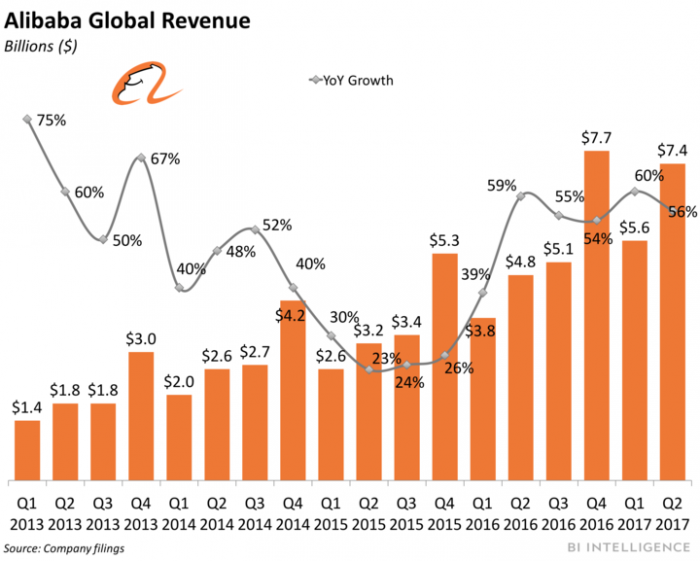Alibaba's future could rely on brick-and-mortar (BABA)

BI Intelligenc
This story was delivered to BI Intelligence "E-Commerce Briefing" subscribers. To learn more and subscribe, please click here.
Alibaba’s chairman, Jack Ma, vice chairman, Joseph Tsai, and CEO, Daniel Zhang, discussed the company’s strategy and vision with Bloomberg on Alibaba’s recent 18th anniversary.
Building out infrastructure seems to be central to Alibaba’s future plans, which appear to focus on the spread and development of physical assets as well as its e-commerce infrastructure, including its marketplaces, logistics, and payments system.
Alibaba is looking to bring the technology and utility of its Hema stores to shopping malls. Hema is Alibaba’s line of grocery stores, which feature technology that allows customers to pay through an app, get additional product information through barcodes, and even make ship-from-store orders. Hema stores also use machine learning to customize fresh food offerings in each location, making each store unique and tailored to consumer preferences. Bringing this technology to malls could boost brick-and-mortar retail sales, as the improvements to the shopping experience and product offerings would likely entice customers.
Alibaba can integrate this technology into malls in two main ways:
The Chinese e-commerce giant can build and acquire stores and malls. Alibaba is already moving on both of these fronts — it acquired Intime department store in January, and it is currently constructing its own mall, entitled More Mall, which is set to open in April. Having full control over its properties could allow Alibaba to maximize the value of its technology, and experiment and create a prototype it can proliferate.
Alibaba could also look to partner with stores and malls, an option Tsai mentioned to Bloomberg. Tsai suggested that acquiring many real estate assets is a bad use of capital, and working with third-party stores might be a better way to go. That could hasten the spread of Alibaba’s innovations, and provide it with a new revenue stream as a retail technology provider. However, it might find difficulty getting stores to take full advantage of its tech.
Brick-and-mortar stores may be the key to Alibaba’s fulfillment future. If Alibaba can extend its store network, it will likely be able to build out its fulfillment operations in tandem, as each store could potentially ship products from store inventory like Hema, helping to ease the delivery process. Zhang suggested that such a development could take Alibaba from generating 55 million packages a day to 1 billion a day. That would dramatically improve the company's logistics capabilities, enabling it to solidify a reputation for speedy fulfillment, and stave off competition from rivals like JD.com.
Brick-and-mortar retailers are caught on the wrong side of the digital shift in retail, with many stuck in a dangerous cycle of falling foot traffic, declining comparable-store sales, and increasing store closures. Over 8,600 retail stores could close this year in the US — more than the previous two years combined, brokerage firm Credit Suisse said in a recent report. Meanwhile, e-commerce pureplays are riding the rise of digital commerce to success — none more so than Amazon, which accounted for 53% of online sales growth in the US last year, according to Slice Intelligence.
In response, many brick-and-mortar retailers have started to use omnichannel fulfillment methods that leverage their store locations and in-store inventory in order to better compete in e-commerce. These omnichannel services, including ship-from-store and click-and-collect, can help retailers manage the transition to digital by:
Increasing online sales by offering cheaper, more convenient delivery options for online shoppers.
Limiting the growth of shipping costs as online sales volumes increase by leveraging store networks for delivery.
Keeping stores relevant by turning them into fulfillment centers that pull customers in to pick up online orders.
However, few retailers have mastered these new fulfillment services. While these companies have spent years optimizing their supply chain and logistics networks for delivering goods to their stores or directly to customers’ doorsteps, most have yet to figure out how to profitably bring their store locations into the e-commerce delivery process.
Jonathan Camhi, research analyst for BI Intelligence, Business Insider's premium research service, has laid out the case for why retailers must transition to an omnichannel fulfillment model, and the challenges complicating that transition for most companies. This omnichannel fulfillment report also detail the benefits and difficulties involved with specific omnichannel fulfillment services like click-and-collect, ship-to-store, and ship-from-store, providing examples of retailers that have experienced success and struggles with these methods. Lastly, it walks through the steps retailers need to take to optimize omnichannel fulfillment for lower costs and faster delivery times.
Here are some of the key takeaways from the report:
Brick-and-mortar retailers must cut delivery times and costs to meet online shoppers’ expectations of free and fast shipping.
Omnichannel fulfillment services can help retailers achieve that goal while also keeping their stores relevant.
However, few retailers have mastered these services, which has led to increasing shipping costs eating into their profit margins.
In order to optimize costs and realize the full benefits of these omnichannel services, retailers must undertake costly and time-consuming transformations of their logistics, inventory, and store systems and operations.
In full, the report:
Details the benefits of omnichannel services like click-and-collect and ship-from-store, including lowering delivery times and costs, and driving in-store traffic and sales.
Provides examples of the successes and struggles various retailers have experienced with omnichannel delivery.
Explains why retailers are having trouble managing costs with their omnichannel fulfillment efforts, which are eating into their profits.
Lays out what steps retailers need to take to optimize costs for their omnichannel operations by placing inventory where it best meets customer demand.
To get the full report, subscribe to an ALL-ACCESS Membership with BI Intelligence and gain immediate access to this report AND more than 250 other expertly researched deep-dive reports, subscriptions to all of our daily newsletters, and much more. >> Learn More Now
You can also purchase and download the report from our research store.
See Also:

 Yahoo News
Yahoo News 

